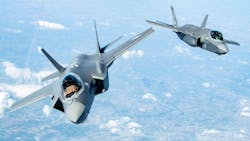U.S. Air Force tests electronic warfare (EW) capabilities for combat aircraft in contested environments
WASHINGTON – The U.S. Air Force has concluded a two-day, $1.4 million exercise that evaluated the ability of the F-35 jet fighter-bomber to provide its electronic warfare (EW) capabilities to other stealthy reconnaissance and bombing planes. C4ISRnet reports. Continue reading original article
The Military & Aerospace Electronics take:
24 Aug. 2020 -- The event earlier this month at Nellis Air Force Base, Nev., tested the ability for the F-35 to provide suppression of enemy air defense (SEAD) support for other stealthy aircraft like the B-2 stealth bomber and the RQ-170 reconnaissance drone.
Other planes that participated included the F-22 and F-15 jet fighters, and the Navy’s E/A-18G EW aircraft. Some scenarios focused on how the latest fourth-gen electronic capabilities could increase fifth-gen freedom of maneuver in contested environments.
U.S. adversaries over the past several years have developed advanced radars to detect incoming combat aircraft, pairing them with long-range missiles that in many cases outgun U.S. military weapons.
Related: Electronic warfare technology heading-up the battlefield
John Keller, chief editor
Military & Aerospace Electronics
